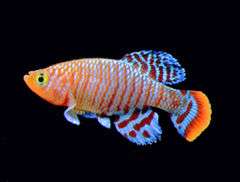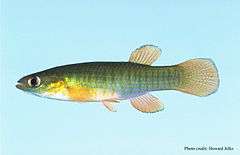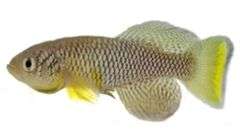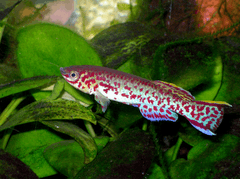Killifish
A killifish is any of various oviparous (egg-laying) cyprinodontiform fish (including families Aplocheilidae, Cyprinodontidae, Fundulidae, Profundulidae and Valenciidae). All together, there are some 1270 species of killifish, the biggest family being Rivulidae, containing more than 320 species.[1] As an adaptation to living in ephemeral waters, the eggs of most killifish can survive periods of partial dehydration. Many of the species rely on such a diapause, since the eggs would not survive more than a few weeks if entirely submerged in water. Like seeds, the eggs can be sent by mail without water. The adults of some species, such as Kryptolebias marmoratus, can additionally survive out of the water for several weeks.[2] Most killies are small fish, from one to two inches (2.5 to 5 cm), with the largest species growing to just under six inches (15 cm).

The word killifish is of uncertain origin, but is likely to have come from the Dutch kil for a kill (small stream).[3] Although killifish is sometimes used as an English equivalent to the taxonomical term Cyprinodontidae, some species belonging to that family have their own common names, such as the pupfish and the mummichog.
Range and habitat

Killifish are found mainly in fresh or brackish waters in the Americas, as far south as Argentina and as far north as southern Ontario. There are also species in southern Europe, in much of Africa as far south as KwaZulu-Natal, South Africa, in the Middle East and Asia (as far east as Vietnam), and on several Indian Ocean islands. Killifish are not found in Australia, Antarctica, or northern Europe.
The majority of killifish are found in permanent streams, rivers, and lakes, and live between two and three years. Such killifish are common in the Americas (Cyprinodon, Fundulus and Rivulus) as well as in Africa and Asia (including Aphyosemion, Aplocheilus, Epiplatys, Fundulopanchax and Lacustricola) and southern Europe (Aphanius). Some of these habitats can be rather extreme; the only natural habitat of the Devils Hole pupfish (Cyprinodon diabolis) is Devils Hole: a cavern at least 300 feet (91 m) deep, branching out from a small opening at the surface, approximately 6 feet (1.8 m) by 18 feet (5.5 m) wide.
Some specialized forms live in temporary ponds and flood plains, and typically have a much shorter lifespan. Such species, known as "annuals", live no longer than nine months, and are used as models for studies on aging. Examples include the African genus Nothobranchius and South American genera ranging from the cold water Austrolebias of Argentina and Uruguay to the more tropical Gnatholebias, Pterolebias, Simpsonichthys and Terranatos.
Territorial behavior

A small number of species will shoal while most are territorial to varying degrees. Populations can be dense and territories can shift quickly, especially for species of the extreme shallows (a few centimetres of water). Many species exist as passive tribes in small streams where dominant males will defend a territory while allowing females and immature males to pass through the area. In the aquarium, territorial behavior is different for every grouping, and will even vary by individuals. In a large enough aquarium, most species can live in groups as long as there are more than three males.
Diet
Killifish feed primarily on aquatic arthropods such as insect (mosquito) larvae, aquatic crustaceans and worms. It is reported by the killifish collector Rudolf Koubek that areas in Gabon where the streams lack killifish (due to pollution or other causes) are rife with malaria, which is spread by a mosquito. Some species of Orestias from Lake Titicaca are planktonic filter feeders. Others, such as Cynolebias and Megalebias species and Nothobranchius ocellatus are predatory and feed mainly on other fish. The American Flagfish (Jordanella floridae) feeds heavily on algae and other plant matter as well as aquatic invertebrates. Nothobranchius furzeri needs much food because it grows quickly, so when food supplied is inadequate, bigger fish will eat the smaller fish.[4]
In lifespan research

Some strains have a lifespan as short as several months and can thus serve as a model for biogerontological studies.[5][6][7][8][9] The African turquoise killifish (Nothobranchius furzeri) is the shortest-living vertebrate that can be bred in captivity, having a lifespan of between three and nine months.[6][7] Sexual maturation occurs within 3–4 weeks, with fecundity peaking in 8–10 weeks.[10]
Nothobranchius furzeri shows no signs of telomere shortening, reduced telomerase activity, or replicative senescence with age, despite its short lifespan.[11][12] Nonetheless, lipofuscin accumulates in the brain and liver (associated with age-related neurodegeneration), and there is an increased risk of cancer with age.[10] Calorie restriction reduces these age-related disease conditions.[10] Resveratrol has been shown to increase the mean and maximum life span of Nothobranchius furzeri,[13] but resveratrol has not been shown to have this effect in mammals.[14]
Transferring the gut microbiota from young killifish into middle-aged killifish significantly extends the lifespans of the middle-aged killifish.[15]
Transgenic strains have been made,[16] and precise genome editing was achieved in Nothobranchius furzeri using a draft genome and the CRISPR/Cas9 system.[7] By targeting multiple genes, including telomerase, the killifish can now be used as an attractive vertebrate model organism for aging and diseases (such as Dyskeratosis congenita).[7] Sequencing the whole killifish genome indicated modification to the IGF-1 receptor gene.[17]
As pets

Many killifish are lavishly coloured; and most species are easy to keep and breed in an aquarium. Specimens can be obtained from specialist societies and associations. Striped panchax (aka. Golden Wonder Killifish) are commonly found in pet shops, but caution must be exercised when considering tank mates, since the mouth of the Striped panchax is as wide as the head, and much smaller fish will be eaten. Flagfish, native to south Florida, is another species of killifish commonly found in pet stores. They are useful in aquariums for algae control. The Golden topminnow (Fundulus chrysotus) is also native to the United States and often available at auction, but care must be taken with these fish – and the Golden Wonder – to stop them from jumping out of the tank. A firm cover and a layer of floating plants is best when keeping these fish.
Behavior-altering infection
Normally, killifish avoid near-surface water to reduce the danger of being eaten by predators. When infected with a certain type of fluke, however, the fish swim near the surface, and sometimes even swim upside down, exposing their reflective bellies (normally camouflage for upward-looking predators, but standing out to downward-looking predators, due to the different background appearance of the top vs. bottom of the water column). The fluke completes its lifecycle in the digestive tract of birds.[18]
Evolved resistance to extreme levels of toxicity
Thanks to the genetic diversity of the species, killifish in the Eastern US have evolved within a relatively short period of time (50–60 years) resistance against levels of dioxins, PCBs, mercury, and other industrial chemicals up to 8,000 times higher than the lethal dose. Sequencing the genomes of the adapted individuals showed a common set of mutations among the pollution-tolerant fish, many of which helping to deactivate or turn off a molecular pathway responsible for a large part of the cellular damage caused by the chemicals.[19]
Killifish were found to fare relatively well in the wake of the Deepwater Horizon oil spill.[20]
References
- List of Nominal Species of Rivulidae (Rivulines) FishBase. Ed. Ranier Froese and Daniel Pauly. May 2007 version. N.p.: FishBase, 2007.
- "Tropical fish can live for months out of water", Reuters, Wed Nov 14, 2007 9:05pm GMT
- van der Sijs, Nicoline (2009). Cookies, Coleslaw and Stoops: The Influence of Dutch on the North American Languages. Amsterdam University Press. p. 198. ISBN 9789089641243.
- "Species File: Nothobranchius furzeri". Killi.co.uk. 2009–2013. Retrieved 2013-02-08.
- Terzibasi E, Valenzano DR, Benedetti M, Roncaglia P, Cattaneo A, Domenici L, Cellerino A (2008). "Large differences in aging phenotype between strains of the short-lived annual fish Nothobranchius furzeri". PLoS ONE. 3 (12): e3866. doi:10.1371/journal.pone.0003866. PMC 2585814. PMID 19052641.
- Valenzano DR, Sharp S, Brunet A (2011). "Transposon-Mediated Transgenesis in the Short-Lived African Killifish Nothobranchius furzeri, a Vertebrate Model for Aging". G3: Genes, Genomes, Genetics. 1 (7): 531–538. doi:10.1534/g3.111.001271. PMC 3276177. PMID 22384364.
- Harel, I.; Benayoun, B. R. N. A.; Machado, B.; Singh, P. P.; Hu, C. K.; Pech, M. F.; Valenzano, D. R.; Zhang, E.; Sharp, S. C.; Artandi, S. E.; Brunet, A (2015). "A Platform for Rapid Exploration of Aging and Diseases in a Naturally Short-Lived Vertebrate". Cell. 160 (5): 1013–26. doi:10.1016/j.cell.2015.01.038. PMC 4344913. PMID 25684364.
- Callaway E (2015). "Short-lived fish may hold clues to human ageing". Nature. 528 (7581): 175. doi:10.1038/nature.2015.18945. PMID 26659161.
- Cellerino A, Valenzano DR, Reichard M (2016). "From the bush to the bench: the annual Nothobranchius fishes as a new model system in biology". Biological Reviews of the Cambridge Philosophical Society. 91 (2): 511–533. doi:10.1111/brv.12183. PMID 25923786.
- Kim Y, Nam HG, Valenzano DR (2016). "The short-lived African turquoise killifish: an emerging experimental model for ageing". Disease Models & Mechanisms. 9 (2): 115–129. doi:10.1242/dmm.023226. PMC 4770150. PMID 26839399.
- Hartmann N, Reichwald K, Lechel A, Graf M, Kirschner J, Dorn A, Terzibasi E, Wellner J, Platzer M, Rudolph KL, Cellerino A, Englert C (2009). "Telomeres shorten while Tert expression increases during ageing of the short-lived fish Nothobranchius furzeri". Mechanisms of Aging and Development. 130 (5): 290–296. doi:10.1016/j.mad.2009.01.003. PMID 19428446.
- Graf M, Hartmann N, Reichwald K, Englert C (2013). "Absence of replicative senescence in cultured cells from the short-lived killifish Nothobranchius furzeri". Experimental Gerontology. 48 (1): 17–28. doi:10.1016/j.exger.2012.02.012. PMID 22445733.
- Valenzano DR, Terzibasi E, Genade T, Cattaneo A, Domenici L, Cellerino A (2006). "Resveratrol prolongs lifespan and retards the onset of age-related markers in a short-lived vertebrate". Current Biology. 16 (3): 296–300. doi:10.1016/j.cub.2005.12.038. PMID 16461283.
- Bhullar KS, Hubbard BP (2015). "Lifespan and healthspan extension by resveratrol". Biochimica et Biophysica Acta. 1852 (6): 1209–1218. doi:10.1016/j.bbadis.2015.01.012. PMID 25640851.
- Tibbs TN, Lopez LR, Arthur JC (2019). "The influence of the microbiota on immune development, chronic inflammation, and cancer in the context of aging". Microbial Cell. 6 (8): 324–334. doi:10.15698/mic2019.08.685. PMC 6685047. PMID 31403049.
- Valenzano DR, Sharp S, Brunet A (2011). "Transposon-Mediated Transgenesis in the Short-Lived African Killifish Nothobranchius furzeri, a Vertebrate Model for Aging". G3: Genes, Genomes, Genetics. 1 (7): 531–538. doi:10.1534/g3.111.001271. PMC 3276177. PMID 22384364.
- Valenzano DR, Benayoun BA, Singh PP, Zhang E, Etter PD, Hu CK, Clément-Ziza M, Willemsen D, Cui R, Harel I, Machado BE, Yee MC, Sharp SC, Bustamante CD, Beyer A, Johnson EA, Brunet A (2015). "The African Turquoise Killifish Genome Provides Insights into Evolution and Genetic Architecture of Lifespan". Cell. 163 (6): 1539–1554. doi:10.1016/j.cell.2015.11.008. PMC 4684691. PMID 26638078.
- http://ngm.nationalgeographic.com/2014/11/mindsuckers/zimmer-text
- Konkel, Lindsey (8 December 2016). "These Fish Evolved to Live in Extremely Toxic Water". National Geographic. University of California, Davis.
- "After Deepwater Horizon spill: Which animals weathered the disaster". www.sciencedaily.com. Rutgers University. March 13, 2017. Retrieved March 15, 2017.
- Costa, Wilson J.E.M. (1998). Phylogeny and Classification of the Cyprinodontiformes (Euteleostei: Atherinomorpha): A Reappraisal. In Malabarba, L. et al. (eds), Phylogeny and Classification of Neotropical fishes part 6 (Atherinomorpha), Porto Alegre. 603 p.
- Huber, J. (2004). Killi-Data Online
- Parenti, Lynn R. (1981). A phylogenetic and biogeographical analysis of Cyprinodontiform fishes (Telostei, Alethrinimorpha). Bulletin of the American Museum of Natural History 168, article 4.
- Fish Lives in Logs, Breathing Air, for Months at a Time- Aalok Mehta, National Geographic News.
External links
- the killi net – Database of killifish names, codes and pictures online since 1996
- American Killifish Association, the first killi organisation of any sort (AKA)
- British Killifish Association (BKA)
- Itrainsfishes – All about South American Killifishes
- Rare Hermaphroditic Fish Survives in Mangrove Swamps – D. Scott Taylor, Ph.D – mangrove.org
- In Short-Lived Fish, Secrets to Aging – Carl Zimmer, New York Times
- The most extreme fish on earth – Matt Walker, BBC Earth